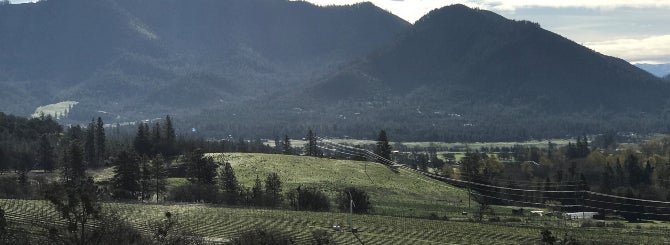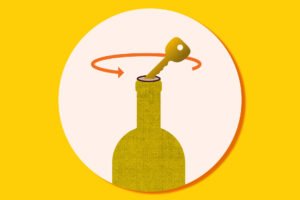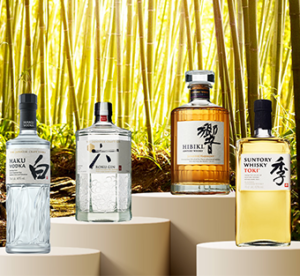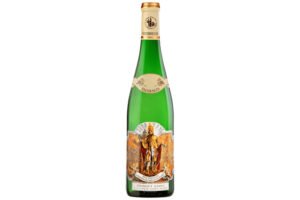Changing Ways for Oregon Wine

[ad_1]
Climate change is altering the way winemakers work in southern Oregon, as conditions move from foggy to fiery.
By Liza B. Zimmerman | Posted Monday, 02-Aug-2021
The past few years of hot weather and forest fires have taken their toll on vineyards in the southern part of Oregon, a growing region that naturally runs much hotter than the established northern Pinot Noir haven of the Willamette Valley. As a result, producers are taking a number of measures to protect the grapes and the workers who have had to harvest them in these tough conditions.
Initiatives include everything from focusing on different varietals to harvesting earlier and irrigating vineyards more intensely and frequently. Smart producers have been slowly changing up their game for some time but new strategies for moving forward are only likely to get more drastic as the heat in the Pacific Northwest – once known as a fairly foggy and cool region of the country – shows little signs of abating.
“The climate has changed to some degree over the entire history of winegrowing,” shares Herb Quady, president of the Jacksonville, Oregon-based Quady North winery. “Grape growers and winemakers tend to make changes over time depending on how successful certain varieties are and how well the wines are received in the market. The issue … is that usually these changes happen pretty slowly, over a period of many decades, but recently they have been happening very quickly,” he concludes. His sentiments illuminate the core problem that many West Coast, and the bulk of southern Oregon, vineyards and producers are experiencing. “The big question is are we able to keep up with these changes?” he asks.
Choosing the right grapes
While many vintners are still experimenting with what grows best in the southern-most growing areas of the state which includes the three major appellations of the Umpqua, Rogue and Applegate valleys in geographically descending order.
“Vineyards that are planted to heat-tolerant varieties and have solid access to irrigation are better able to tolerate the heat,” notes Quady. However, he adds that Pinot Noir is the most commonly planted grape in southern Oregon. That is not surprising given the demand for it across the country, and the world, however it might seem a bit unusual to grow such a finicky grape that tends to thrive in cool climates in warmer parts of the state.
“The landscape of Oregon viticulture needs to start shifting now and not waiting until it’s too late,” concurs Nate Winters, a certified sommelier and national sales manager at Troon Vineyards in the Applegate Valley.
“There is a lot of Pinot Noir planted in Southern Oregon and that may be a problem for a lot of growers. Pinot Noir ripens before almost everything and when it’s grown in a really warm climate the sugars accumulate faster than flavor does. This means you can’t achieve the same complexity in the wine as you would if you grew Pinot Noir in a cool climate. As our heat intensifies, I can only see these grapes struggling more than others.”
In the vineyards, some growers are also seeing other varietal shifts as well.
“We are considering varietals that would have been unheard in days gone by. We’re now seeing excellent Barbera, Cabernet Sauvignon and Zinfandel being grown here in the valley. Ten years ago, it was tough to reliably ripen those varietals because it wasn’t hot enough late in the season,” shares Dennis O’Donoghue the owner of the Eagle Point, Oregon-based Celtic Moon Vineyards LLC. He adds that a higher demand for irrigation water when it is becoming ever scarcer could drive growers and producers to plant more drought-resistant vines and varietals.
Luckily, many producers seem to be right on track about what they proactively intend to plant given the current brisk pace of climate change. Alan Journet, a co-facilitator at the Jacksonville-based Southern Oregon Climate Action Now organization says that winemakers seem to be on the right path in terms of choosing varietals for a warmer future, according to data provided by Greg Jones, the former director of wine education at Linfield University in McMinnville, Oregon. Some producers, he adds, are even growing the right varietals for the predicted climate the region is slated to experience in 2075 to 2085 in terms of weather. Those grapes in include Tempranillo, Cabernet Franc, Merlot and Grenache, he adds. “What is of concern, however, is that if we achieve the extreme future conditions, table grapes and raisins will be the order of the day here.”
The heat is on
How much damage done to a vineyard in a heatwave depends on when temperatures rise relative to when grapes are harvested and this algorithm may continue to affect what grapes continue to be successful in Southern Oregon vineyards.
Quady notes that late heat waves can cause more stress than earlier ones, particularly for certain varieties like Pinot Noir which he adds “is sensitive to heat after veraison”. He adds that “early heatwaves are not as much of an issue, as long as the vineyard has irrigation and it is properly scheduled [in terms of harvest]”.

© Turrel Group
| Producers like Quady North have started harvesting at night to ease the stress on the grapes.
He goes on to note that certain grapes have often thrived in hotter temperatures. “These seasons have been great for Grenache and Mourvèdre, two varieties that in the last decade were often difficult to fully ripen for red wine. There are other varieties that we will plant that need an even hotter climate, like Carignan, Cinsaut and Counoise.” He adds that they are all part of the same family and can, hence, work well together in the Rhône red blends that are made in parts of southern Oregon.
He goes on to note that he has also been shifting some of his grape production to the cooler Applegate Valley AVA. He adds that producers up north in the more-established Willamette Valley also seem to be following suit – according to current climate shifts – by planting Syrah and Viognier, which are both grapes that need much warmer weather than the grapes that would have thrived in northern Oregon’s previously cooler vineyard sites.
A move to hydrate
Most of the producers in Southern Oregon irrigate their grapes and doing so before a heatwave can also help the plants get through it.
“Hydrating soils two to three days preceding a heat event to give the vines access to water in the root zone certainly helps,” shared Jones, before he left Linfield. He adds that over the past few hot summers he was sure “that most [producers] who have irrigation capabilities did this”. Most vineyards in southern Oregon are irrigated and “that is a huge benefit”, shares Dan Marca, the co-owner of the Jacksonville-based producer Dancin Vineyards.
Luckily many producers in the area have been generally forewarned – in recent years – before a heatwave comes to town. “We had good forecast of the last heatwave and I asked all our source vineyards to pre-soak before the heatwave. Because of this, I haven’t seen any stress so far,” Quady says.
Another preventative measure that Quady is looking at is night harvesting. “Basically, you start at 9-10pm at night and pick all night when it’s cooler. You have to set up lights and wear reflective vests for safety. It’s a great idea. The only issue is trying to shift everyone’s schedule to accommodate that. I’m going to look at it again this year. We may be able to create a crew that can shift their schedule to pick at night. It could really help with the early varieties like Pinot Noir, Pinot Gris and Chardonnay.”
He is not alone in turning to night harvesting. At Celtic Moon Vineyards, O’Donoghue adds that it “allows us to harvest faster and harvest at night when temperatures are cooler”.
“Finally, we need to change how we allocate water. We have a better system than California, because we regulate the entire watershed, including wells,” shares Quady. “However, we don’t discriminate in terms of crop types and how they are watered. This makes for inefficient distribution of water. We need to re-allocate the water on a total volume basis,” he concludes.
A new approach
Many smart producers are looking at more heat-efficient ways to train and trellis vineyards. “An open canopy that gives some shade is most popular in warmer regions like Napa and the Central Valley and more vineyards would do well to switch to that,” noted Quady.
O’Donoghue, the grower, agrees that there will be “more emphasis on canopy management to shade the grapes and maintain a healthy balance between fruit growth and vegetative growth. [In addition]…managing the crop load is important. With higher temperatures, we drop more fruit so there are less clusters per vines, giving us a fighting chance of ripening the remaining clusters under the conditions of decreased metabolic activity of the vines.”
He concludes that “certainly our wine styles [in the southern part of Oregon] will change and the varietals that were known for may be different. That may not be a bad thing. We may become world-famous for a few particular varietals that would thrive in our ‘new normal’ of climate. With every crisis comes opportunity.”
[ad_2]




